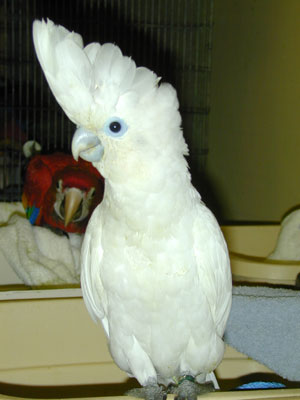Cockatoo - Ducorp's
Ducorps Cockatoo, Salomonenkakadu Scientific Name: Cacatua ducorpsii
Sat, 5th July, 2025 - 8:59 pm GMT
Sponsor Ads:

Alternative Name
Ducorps Cockatoo, Salomonenkakadu Scientific Name: Cacatua ducorpsiiBasic Info
Ducorp's Cockatoos grow to about 13 inches in length. They have predominantly white plumage although sometimes the hidden bases of the head and breast feathers have a carnation pink base. Their crests are round and very broad. Ducorp's Cockatoos have pale yellow undersides to their wings and tails. Their feet are gray and their bills are grayish-white. Males have dark brown or black irises, while females have more red coloration in their irises.
Health
If you must keep your Ducorp's Cockatoo in a cage, be sure it gets plenty of exercise. The cage should not be smaller than 30 inches square and 30 inches tall. Breeding In the wild, Ducorp's Cockatoos breed from July through December, and build their nests in holes of branches or tall trees. They return to the same nest each year. A clutch consists of two to three eggs in the wild, but in captivity they may produce up to four eggs. They tend to be quite difficult to breed in captivity, where their breeding season starts in May. Ducorp's Cockatoos require a nesting box of about ten by 12 by 20 inches in dimension, and it is very difficult to pair these Cockatoos compatibly. Often the male will attack the female. Pairs are quite aggressive while breeding and must be isolated; if disturbed, they may harm each other or their eggs. The incubation period lasts about 28 days and often Ducorp's Cockatoos abandon their young, who must be hand reared by the breeder. Immature Ducorp's Cockatoos have grayer plumage than adults and dark irises. Females acquire their characteristic red irises at two or three years of age.Habitat
Their range covers forests and forest edges, mostly, and even extends into the lower edges of the cloud forests below 5,700 feet in elevation.Behavior
Ducorp's Cockatoos, quieter than most Cockatoos, make sweet pets. They remain quite rare in aviculture, however. Ducorp's Cockatoos are sweet, quiet birds. They may attack their peers in small aviaries, and thus should not be kept in communities. In the wild, they are relatively non-social also and are generally found in pairs, although occasionally they are seen in small groups containing eight birds or less. In the wild, Ducorp's Cockatoo perch in the tallest trees and when they do come down to the ground to drink or feed, they are very cautious. Lookout birds are stationed in nearby trees and if they feel threatened, the entire group will fly off screeching. Ducorp's Cockatoos eat nuts and seeds, fruits and vegetation. On occasion they will descend in large numbers on local agricultural plantations and cause a great deal of damage; however, they are never harmed by farmers. In aviculture, Ducorp's Cockatoos need an aviary of at least 12 by six by six feet in dimension. Although they are relatively hardy, they must be protected from winter frosts. In captivity, Ducorp's Cockatoos are very good at talking, although they are fairly quiet as a rule. The Ducorp's Cockatoo is reported to be quite intelligent and playful in captivity. And they are also said to be quite adaptable around new people. They should be given plenty of toys to keep them from getting bored. They are also reported to be excellant escape artists! So this should be kept in mind when housing them. Some owners have resorted to using mini-locks on their cages to prevent unwanted breakouts.Origin
Solomon IslandsHistory
Ducorp's Cockatoos are quite rare in aviculture. They are native to the Solomon Islands, where from time to time they may cause considerable damage to local banana, papaya, and sweet potato plantations. Nevertheless, the inhabitants of the islands never harm these lovely birds.Common Foods
Ducorp's Cockatoos do well when fed fresh fruits and vegetables, oats, safflower and sunflower seeds, rice, wheat and buckwheat. They need regular vitamin and mineral supplements and plenty of fresh water at all times. Ducorp's Cockatoos also enjoy freshSponsor Ads:
Religion stops a thinking mind.
Cockatoo - Ducorp's
Coded by: BGID® | ALL RIGHTS RESERVED Copyright © 2000-2025
Disclaimer | Privacy | Report Errors / Contact | Credits
















